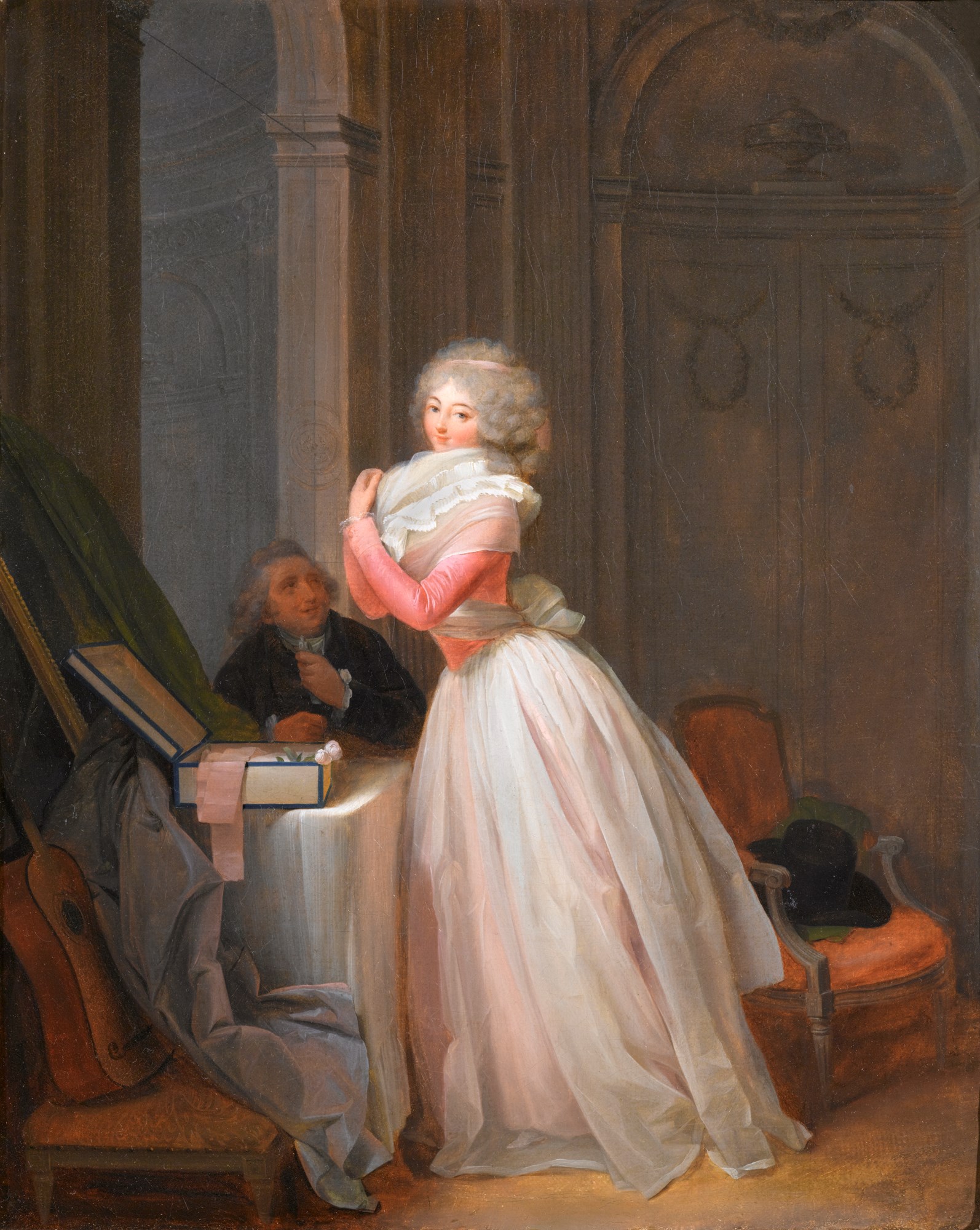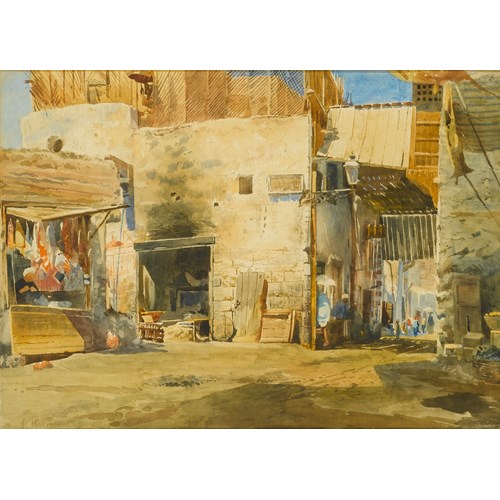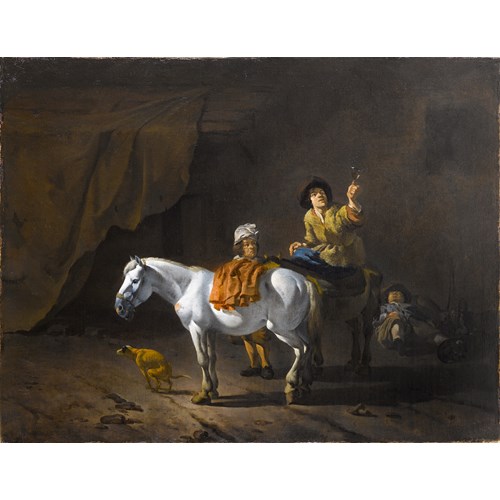Louis Léopold Boilly
The Suitor’s Gift
Period 1750-1850, 18th century, 19th century
Origin France
Medium Oil on canvas
Dimension 46.3 x 37.7 cm (18¹/₄ x 14⁷/₈ inches)
Boilly has skilfully captured the light falling on the dress of the woman, not only highlighting the sumptuous material of her gown, but also making her the focal point of the composition. In particular, the lace detailing of her mantle is crisp and white as the light reflects off the tangible fabric. The Suitor’s Gift is a typical example of Boilly’s depictions of young women, as illustrated by a comparison with the Hermitage’s The Painter. In this work the subject has a similar coquettish appearance, as she meets the viewer’s gaze with an attractive, confident and smiling face. Both women also seem to be of a similar social standing, as shown by the beautiful elegance of their attire.
The young woman’s dress, in the present work, is typical of those worn in the last two decades of the eighteenth century. Her corseted waist, though small, is less artificial than the mid-century fashion for tightly-nipped waists, while the full-length sleeves of her caraco (a jacket-like bodice worn with a petticoat) is characteristic of 1790s ladies’ fashion. Her hair is also simply and softly dressed in a mass of curls - a style that became more prevalent in the 1780s. Self-Portrait of Rose Adélaïde Ducreux with Harp by Rose Adélaïde Ducreux, painted in 1791, offers an excellent stylistic comparison to the present work. Here, Ducreux is depicted wearing a similar feather-light lace mantle over her shoulder which is then tied at the back in a bow, while her flowing curls are plainly dressed with a double ribbon.
Between 1789 and 1791, Boilly executed a series of eight small scenes for the Avignon collector Esprit-Claude-François Calvet. These paintings focused on moralising and amorous subjects. Two of the series are now housed in the Wallace Collection, London: The Visit Returned shows an elegantly dressed young woman, accompanied by her maid, visiting her lover, who sits at his writing desk in the process of writing her a letter. He has placed the lady’s portrait above his desk as he searches for words to express his love. As in the present painting, Boilly has skilfully cast a shaft of light, this time from the open doorway, to illuminate the visiting female figures, while the male figure is firmly secondary in the gloomy shadows.
The other work in the Wallace Collection, The Sorrows of Love, shows a young woman in a state of desperate grief fainting into the arms of a female companion. Behind her a servant returns her mistress’ portrait and an unopened letter. The young woman’s love affair has been brutally ended and so in the Wallace Collection’s paintings Boilly has depicted both the good and bad sides of amorous affairs.
Although the present work was not part of the Calvet series, it nevertheless epitomises the niche area that Boilly cornered in presenting genre scenes of contemporary Parisian life. The Suitor’s Gift is in the same tradition of bourgeois genre scenes, which examine the many sides of love. These works were greatly sought after by the public and collectors alike, and it seems probable, therefore, that the present work was completed to satisfy a taste for these subtle, yet highly charged scenes.
Work's such as The Painter perfectly explain Boilly’s standing as one of the most important genre painters in the late eighteenth and early nineteenth centuries. Here the pretty, almost doll-like women ooze grace, charm and elegance. The documentary precision in his rendition of the costumes and hairstyles of the period are combined with a desire to hint at the psychology of his characters; thus allowing for multi-layered interpretations of his paintings. These works ‘are characteristic of the eighteenth century in that they exhibit a strong predilection for subjects that are sentimental, anecdotal, moralizing, gently erotic, or various combinations of each’ that were increasingly favoured and collected by the Russian Court.¹ Artists such as Jean-Antoine Watteau (1684-1721), François Boucher (1703-1770) and Jean-Honoré Fragonard (1732-1806) - all of whom inspired the young Boilly - chose to depict their subjects within moralising, sentimental and amorous settings, as well as delighting in the tactility and sumptuousness of fabrics. Watteau’s La Boudeuse (The Capricious Girl), for example, completed in c.1718, and now in the Hermitage, is closely connected in composition and theme to the present oil. In La Boudeuse, the subject of the work - a young woman - is nonchalantly aware of her, clearly older, suitor’s attentions as he perches behind her. Her upright posture is confident and poised, while her slight backward gaze to him is indifferent yet beguiling; much like the young woman in the present work. Both works delightfully portray the subtle tensions and moods that accompany seduction.
Boilly was born in Douai in northern France but moved to Arras at the age of seventeen to receive instruction in trompe l’oeil painting from Dominique Doncre (1743-1820). Seven years later Boilly moved to Paris where he exhibited in the Salon between 1791 and 1824 - receiving a gold medal in 1804. As discussed above, his early works tended towards a preference for amorous and moralising subjects. The Suitor’s Gift is comparable to much of his work in the 1790s, which ‘dealt with the love and family life of the urban middle and upper classes’.² His small-scale paintings with carefully mannered colouring and precise detailing - as demonstrated in his execution of the trinket box in the present painting - recalled the work of Dutch seventeenth-century genre painters such as Gabriel Metsu (1629-1667), Willem van Mieris and Gerard ter Borch (1617-1681), of whose work Boilly owned an important collection.
In 1794, Boilly was condemned by the Comité du Salut Public, at the height of the Terror, for the erotic undertones in his work Lovers and the Escaped Bird (The Louvre, Paris) and for painting subjects ‘d’une obscénité révoltante pour les moeurs républicaines’. This offence was remedied by an eleventh-hour discovery in his home of the more patriotic Triumph of Marat (Musée des Beaux Arts, Lille) which saved him from serious penalties. After the righteousness of the Terror, Boilly produced far less of these mildly erotic scenes and began to produce far more crowded compositions that which serve as social chronicals, an example being the Hermitage’s Game of Billiards (1807, The Hermitage, St. Petersburg; Yusupov Palace Museum, Leningrad. 1925). As Hallam notes ‘Boilly’s attitude toward genre painting has obviously changed, and the primacy of sensibilité has been conditioned, and at times replaced, by a journalistic desire to record and document everyday life’.³ As well as genre scenes, Boilly was well respected for his portraiture, producing many portraits of the middle classes and other famous contemporaries (for example, Robespierre now in the Musée des Beaux Arts, Lille) and recording fashionable Parisian life through the Revolution, the Directory, the Empire, and on into the Restoration period.
Both Etienne Bréton and Pascal Zuber have studied transparencies of this painting, and have confirmed that it will be included in their forthcoming catalogue raisonné on the works of Boilly.
¹ Hallam, J. S., ‘The Two Manners of Louis-Léopold Boilly and French Genre Painting in Transition’ in The Art Bulletin (vol. 63, no. 4, Dec. 1981), p. 618.
² ibid. p. 619.
³ ibid. p. 623
Period: 1750-1850, 18th century, 19th century
Origin: France
Medium: Oil on canvas
Dimension: 46.3 x 37.7 cm (18¹/₄ x 14⁷/₈ inches)
Provenance: Anonymous sale, Vienna, Wawra, 7 April 1930, lot 152;
Mrs and Mrs Hugh F. Packenham Borthwick Norton;
thence by descent to Mrs. Eva Sardinia Borthwick Norton (d.1988), of Southwick House, Purbrook, Hampshire, by 1952;
bequeathed by her Executors to The Royal Scottish Academy in 1990.
Literature: To be included in the catalogue raisonné of Louis Léopold Boilly, currently being prepared by Etienne Bréton and Pascal Zuber.
More artworks from the Gallery









